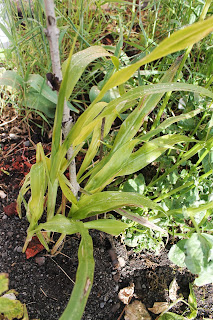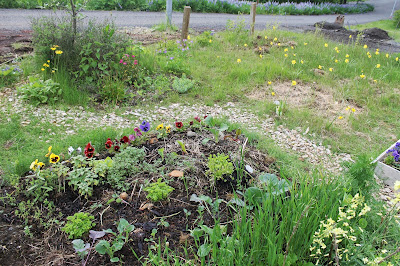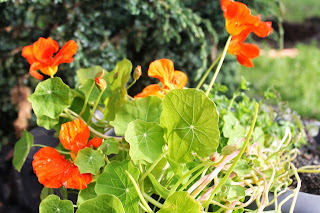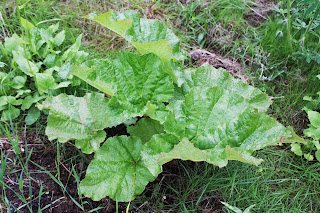Once again an update. June is just finishing and there was no summer weather until now. Except for a few rare days, the temperature has barely risen above 10°C and weeks of constant rain. Best case scenario, in a few sunny days, the temperature has risen to 17°C, which is still little, compared to the 20-22°C recorded in many days of the last years, even in colder months like May or August.
Today we had even a little bit of ice shower, with daily temperatures just above 5ºC, while at night they dipped to 3ºC, here and down to 1ºC at a few spots near the coastline and by the mountains. It has been the coldest summer day for a long time.
 |
| General view of garden. Lots of flowering going on |
Still the Siberian tomatoes are growing
The Siberian tomatoes have flowers on them - these flowers were totally obtained outdoors. It was a 2 month tomato seedling about 8cm tall, at the first week of May (after the last major frost). It survived many minor frosts and is now a dwarf 15cm tall flowering tomato plant. In theory, if I would had started in a larger container, with a warmer greenhouse temperature, I would need only 1.5 months to transplant a larger plant outdoors by June.
Newer flower-free tomato seedlings have not flowered yet. However they seem to grow way faster than the conventional varieties of tomatoes (which actually do not grow at all in such chilly weather!) Transplants that had already began to set fruit (inside the greenhouse), are setting gradually larger fruit but which has not ripen yet.
Most vegetables are growing very slowly (compared to previous years), and even wild flowers have been quite late. Flowers typical of April have been flowering in June.
Still, we are seeing quick growing Broccoli and Pak Choy (damaged a little by slugs due to such moist weather), and the first flowers outdoors of peas and broad beans. Interestingly, all of these seem to prefer a sunny location, even if exposed to the winds and chilly nights, than a more sheltered spot, with less sunlight.
 |
| A line of pak choi was planted. To the left, spontaneous seedlings of pak choy and kale appeared. |
The walking onions, leeks, spring onions have been growing slowly but steadily. The carrots have just germinated. The multiplier onions and chives are very nice. Actually anything that overwinters in Iceland (and stores reserves in their bulbs) fares very nicely during the cool Icelandic summer!
"Perennials are the key" - I repeat my mantra, i got this insight a few months ago. Thus I have an excellent patch of rhubarb, Scottish lovage, strawberries, scorzonera, raspberries and currants, good king henry, crambe, perennial 9 star broccoli, and self-sowing siberian kale.
 |
| Multiplier onions and chives |
The wonders of Huegelkultur in Iceland
Some heirloom peas were planted from seed at a huegelkultur at the sheltered spot, in a part shade location. However they have been growing very quickly! Same thing, for all the vegetables (peas, swiss chard, nasturtium, letttuce, fennel, carrots) sown in a huegelkultur container tray. It was an excellent idea, since it provides maximum fertility, maximum soil aeration, maximum soil life, maximum moisture, and maximum soil temperature, since it is a raised "bed".
The potatoes are in a sort of huegelkultur, but with only a few wooden branches and plenty of seaweed, compost, green manure (the lupins around), and a lot of clipped grass! Sown in May and they are up to 40cm tall. Excellent, despite the chilly summer.
 |
| Potatoes growing in a bed full of branches, compost and cut grass |
 |
| This is the sheltered spot behind our house, facing a forest to the east side. |
Broken promises
The cherry tree is a failure. The guy that sold us the tree (and it was quite expensive) said it was possible to have cherries cropping in Iceland, with some patience and shelter. He said the tree had a lot of buds that would flower. Only 7 flowered, and in my most sheltered spot, only 3 buds remain now. Obviously this summer has been lacking sunshine, and it has been chilly and rainy, and even windy at times. Even this Stella cherry variety is not going to crop anything!
The cold resistant painted mountain corn is very sluggish. A few plants have died, most have been growing slowly. It fares ok in sheltered spots but it lacks that kick of mild sunny days. I wonder whether it is going to crop at all. Indoors, this corn is growing nicely but has not tasseled yet. It should by the end of July. The outdoors corn must tassel at latest by early August (since the first frosts will arrive within a month), so I really don't expect anything from it.
 |
| Painted mountain corn, survived frost and snow, and is growing well, but slowly |
Even the squash has been very slow this year. It does not have flowers yet. When it usually starts cropping fruit by now. Guess that the melon and watermelon are not growing at all, and that the pumpkin seedlings are near to their demise!
Grains - barley and oats are the easiest in Iceland
Indoors, I have been having the heading of teff and pearl millet (the fastest growing grains of all - heading in 4 months since sowing in February). Outdoors, rye is heading, 3 months later, after it was transplanted after 2 weeks of growth in a tray, in March, in plain frosty weather.
 |
| The overall view of our grain bed (3m x 2m). From nearest to furthest: oats, rye, barley and wheat. These are also growing under a fleece to the left side. Two potatoes appeared between the rye. |
 |
| Kamut wheat, the slowest growing of all grains here |
 |
| The hulless oats were even faster! They are now heading in the sunniest location, just 2.5 months after they were sown (but they were growing 1 month in a tray, during the month of April). |
 |
| The perennial rye shows fantastic multi-tillering, but hasn't head yet. The wheat is rather slow and I doubt that it will crop, even if it was sown in late April. |
 |
| The barley is near heading (but not yet), it is still ONLY 2 months after sowing, although it was growing in a tray indoors during the last week of April. |
Clearly, the barley and oats are the easiest grains to grow in Iceland! Rye seems to produce more heavily, though it needs to overwinter, and the problem is finding a variety that does not break with the severe winds.
 |
| In the southwest side, oats is already heading. Its much more exposed and sunny here |
 |
| Rye is also heading, in the southwest side. It is intercropped with broad beans. Both grow well and support each other, during windy weather. |
More pictures!
 |
| Beautiful garden.... |
 |
| Broad beans and peas in nearest bed, more distant are flowers, brassicas and some perennials |
 |
| Pink tulips |
 |
| Nasturtium, growing in a container |
 |
| Black tulips! |
 |
| Black tulips, and garden in background |
 |
| First time I cooked with moringa, galangal, and nasturtium flowers |
 |
| The rhubarb |
 |
| Seed balls germinating... |
 |
| Perennial rye, in close-up |
